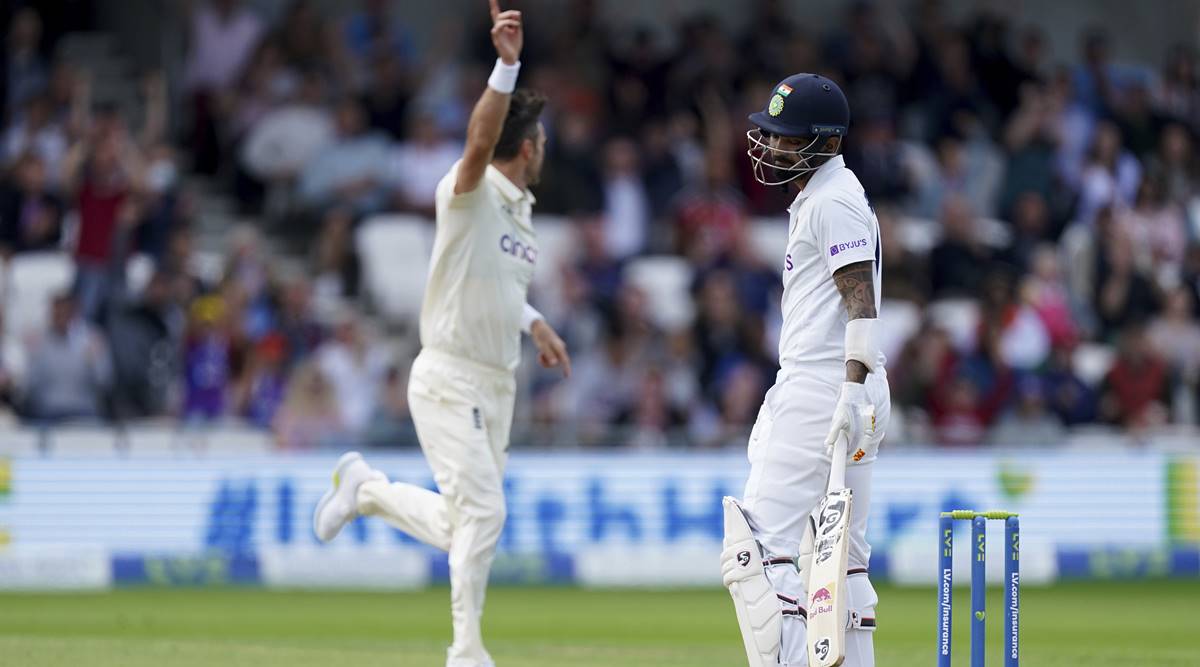It was the combination of their ineptitude and James Anderson’s mastery that culminated in a horror first day for the visitors.
IT was not a monster surface that was responsible for the Indian batsmen’s swift procession to the dressing room on Day 1 of the third Test at Headingley. It was the combination of their ineptitude and James Anderson’s mastery that culminated in a horror first day for the visitors.
It was as if the eight-day recess had dulled the resolve and resilience of India’s batsmen. While India’s batting line-up is flawed and prone to malfunctioning, they seemed to have compensated for these deficiencies with an unbreakable mindset. Here, they lost that spirit to capitulate for 78 all out.
Sunshine in England is the best time to pile runs in the country, but not perhaps in the first session of a Test match, not at Headingley of all venues, though the ground is no longer seen as a seamers’ paradise it once used to be. Anderson, with the wine-dark Dukes ball and pent-up angst since the Lord’s Test, made telling blows early in the Test.
The masterful seamer is an illusionist when the mood seizes him, which has of late dwelled permanently on him. So KL Rahul, the apostle of discipline this series, was deceived into thinking that Anderson had slipped in a rare, juicy half-volley he could coax into a cover-drive. But the ball was not quite as full as he had imagined and ducked away fractionally after pitching, snaring his edge. It was a classical set-up. Three in-swingers, and an out-swinger. A classical Headingley dismissal, a deck that rewards fuller lengths than any other in England.
But as much as Anderson’s veritable tricks, the wicket bore the stamp of Rahul’s indiscretion. It was the sort of audacious drive a well-set batsman imagines towards the end of the day, but not on the fifth ball of the day, when he is getting his eye in, when feet movement is tuning up, when the hand-eye coordination is just syncing. It was the streak of expansiveness Rahul had resisted all through this series. At Lord’s and Trent Bridge, he had left umpteen such deliveries undisturbed.
At Headingley, the drive accompanies a statutory warning of hazard. The extra bounce and late movement the surface offers make the drive a low-percentage stroke in the first session, even if the sun is blazing down and the ball does not seem to do anything malevolent.
The drive again
Virat Kohli didn’t learn from Rahul’s mistake either. The Indian skipper was jumpy at the crease — as he has been throughout his barren spell of runs — and chose to drive a wide delivery through the covers, slightly away from his body. Anderson had, shrewdly, pitched the ball a touch shorter than the usual good length, thus sucking him into the shot, before making the ball move away a touch. Had Kohli pulled off the stroke, he would have stamped his authority. But that was not to be.
One could marvel at the control and craft of Anderson, but Kohli was guilty of indiscretion. It was not an opportune moment to counterpunch, but a time to knuckle down and grind runs, much in the template India had accumulated runs during this series.
Both deliveries would have sailed wide of the off-stump if the batsmen had only chosen to leave them alone. Rahul’s could be an aberration, but Kohli’s is a cause of concern, as he has perished to deliveries he could have left alone this series, bringing to mind the series of such dismissals against Anderson in the 2014 series. He seems to be afflicted with a throwback counter-productive over-eagerness.
Familiar failings
The rest succumbed in a grimly predictable pattern, to well-drilled plans than any magic dust. Cheteshwar Pujara these days is so unsure that he pokes at anything outside the off-stump, and the ball gets sucked into the edge of his bat like an iron-nail towards a magnet. He followed a full Anderson away-swinger that left late. Again, another Indian batsman had tried to play a ball he could have avoided.
Ajinkya Rahane, after nurdling and nudging, hung his bat too, at a back-of-length ball from Ollie Robinson. The line was closer to the stumps, but the length, the bounce the surface generated and the natural lift the tall seamer bargained would have taken the ball over the stumps.
Rohit Sharma, after all the abstinence from drives, let his favourite pull shot be his nemesis for the third time this series. England’s bowlers had not quite tempted him with the pull, but whenever they banged one in, he had looked to take them on. This one was the softest of the three, as he tried to fetch a pull from outside off and spooned a dolly to mid-on. But it’s time this recurrence is corrected.
Rishabh Pant had his regular uncertain waft outside the off-stump — the outcome of a three-pronged dilemma to cut, drive or leave — while Ravindra Jadeja completely missed the line of a full-length Sam Curran ball.
How to explain the meltdown? This was a tricky pitch but not exceptionally so: it did enough but not too much. But batsman after batsman was drawn into playing at almost every ball. Those responsible for India’s worst batting nightmare since the 36 all out in Adelaide were the batsmen themselves. It was a case of technical incompetence as well as of wrong shot selection. Blame not the 22-yard strip.
Source: Read Full Article


